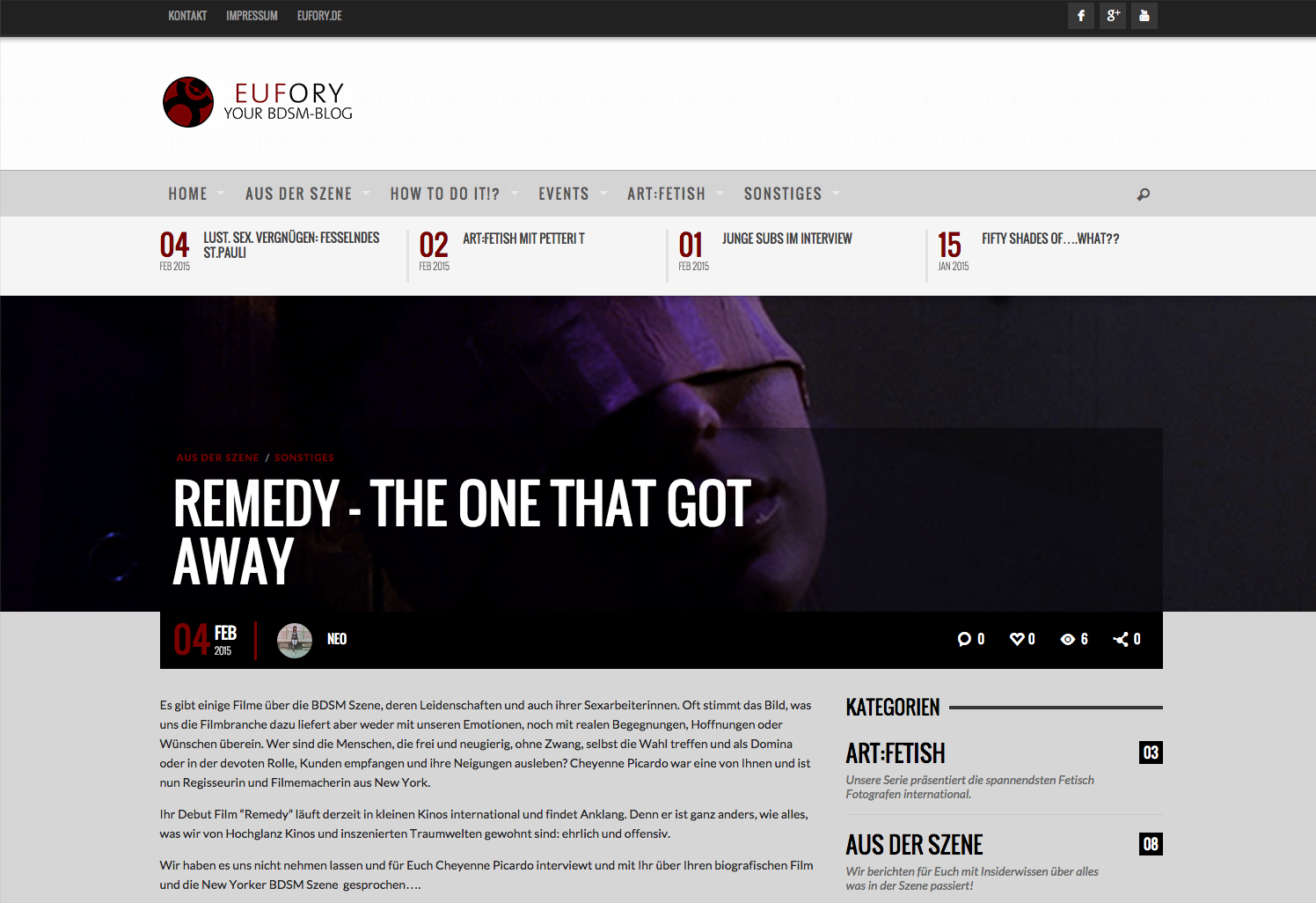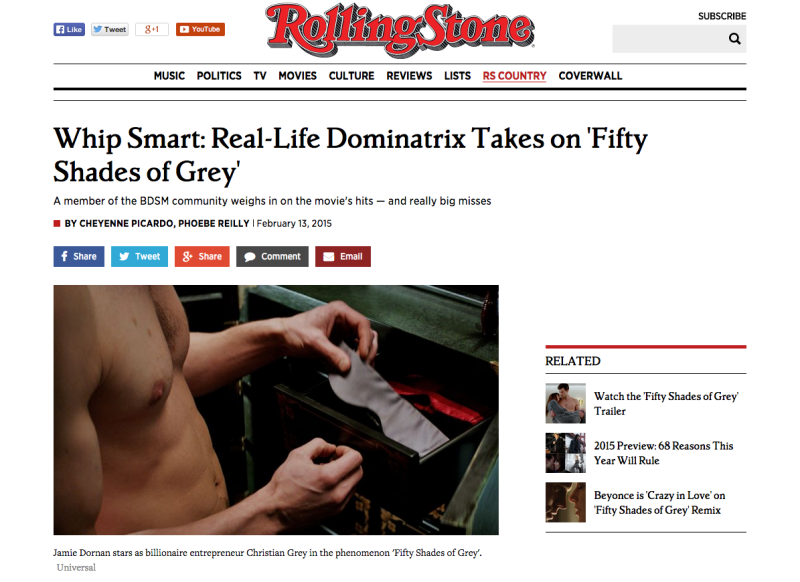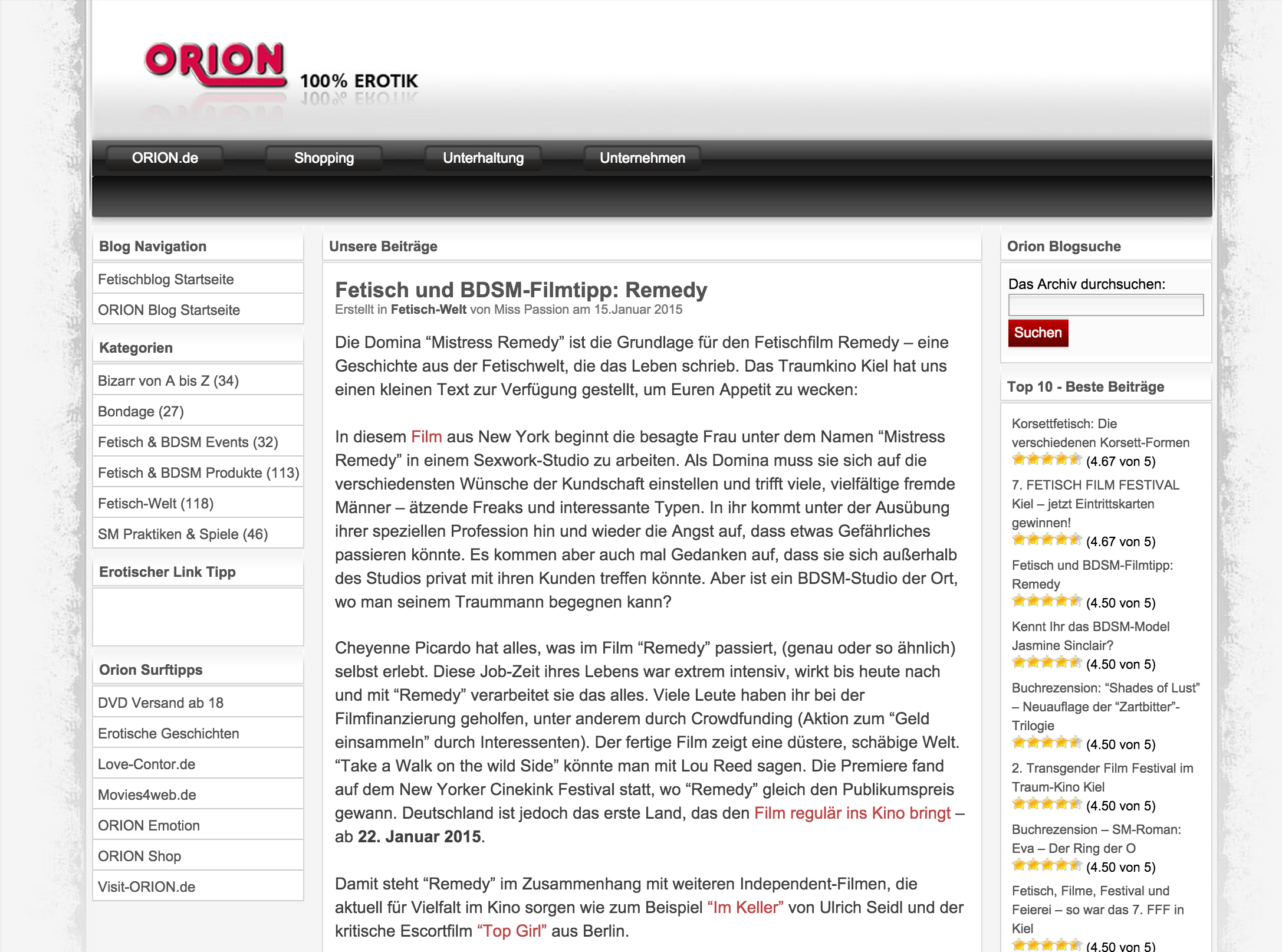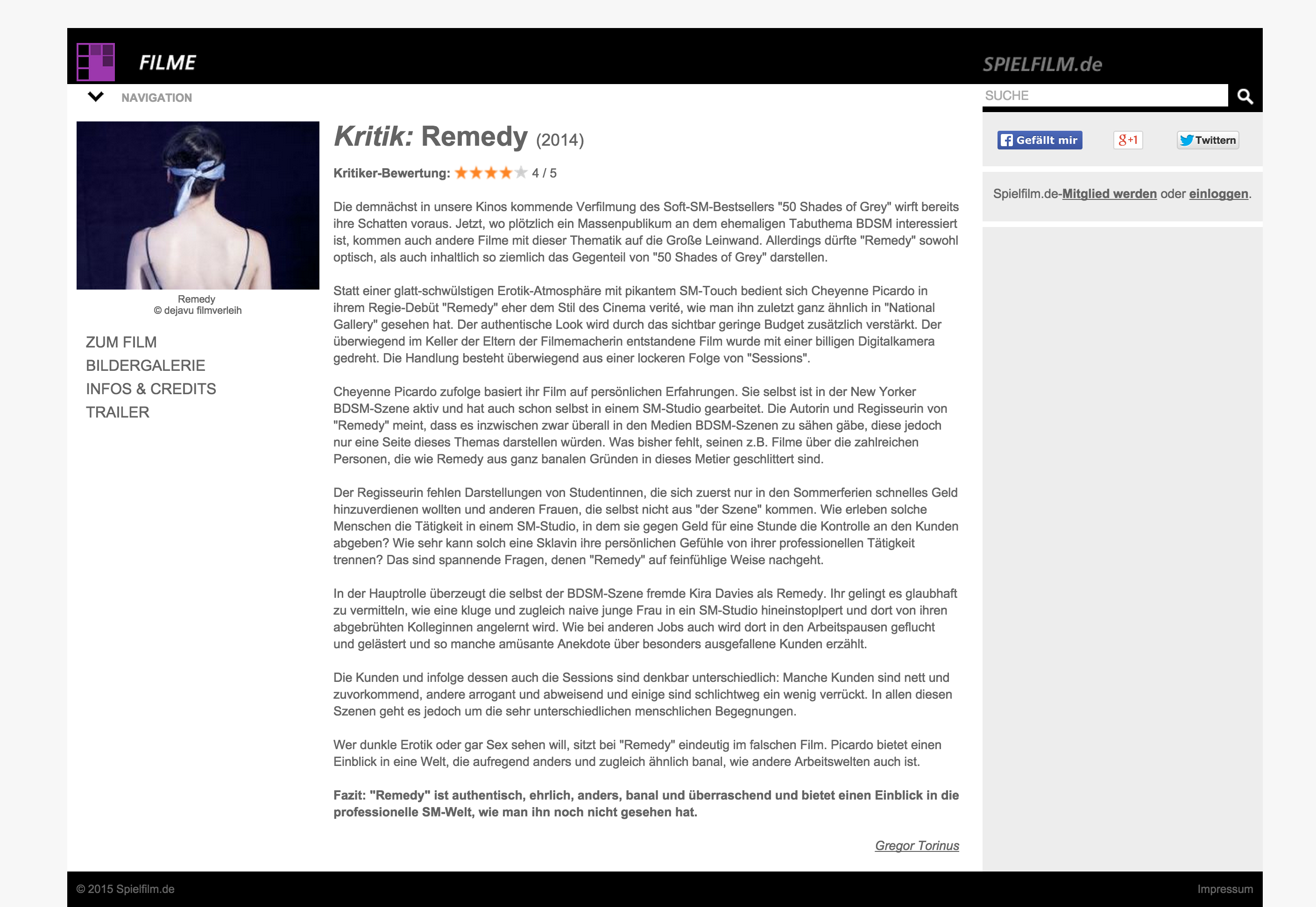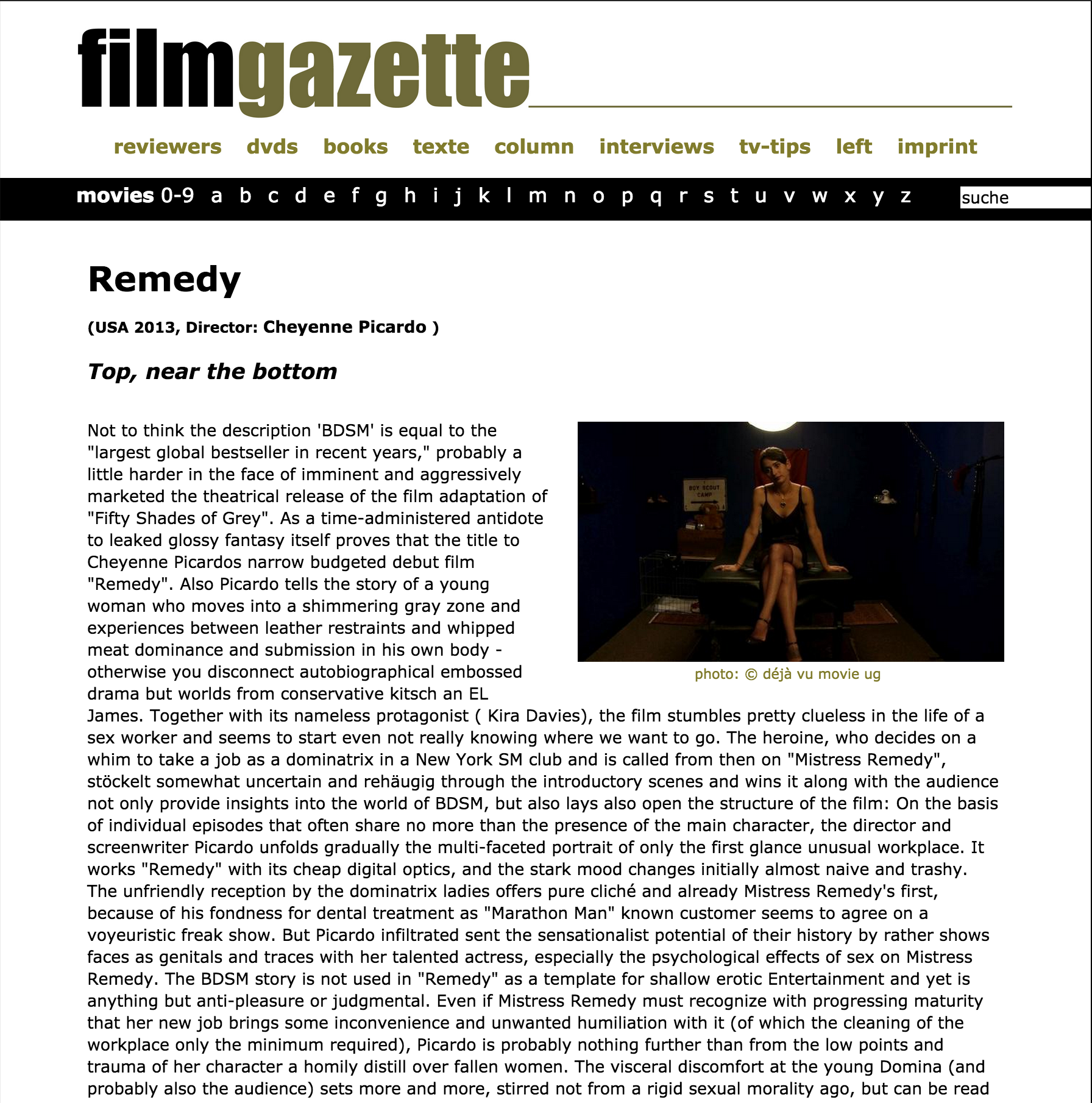What is your movie Remedy all about?
Remedy is an autobiographical fiction based on my time working as a staff (rather than independent) switch in a commercial BDSM dungeon in New York City. It’s my first feature film as producer, director, writer, and editor.
What kind of a woman is Mistress Remedy?
Unabashedly kinky, curious, independent and intelligent. But her tragic flaw, like mine, is her pride. She is type of person who behaves rationally until someone tells her she’s not allowed or not able to do something. Someone who doesn’t recognize when to cut bait and walk away.
But if I didn’t have this “flaw,” I’d never have had the courage to finish this film. So maybe it’s not such a defect after all.
What were your intention to produce that movie? (Why the topic BDSM?)
The intention was not to make a film about BDSM – there are other movies that would do that a lot better than this one. This is a film about profession fetish work. I had read memoirs by other dommes, and what struck me about them was how different their experiences had been from mine, how they sounded like sexual superheros. I found it hard to relate. The experience of a house domme is a very different thing than that of an independent. And I had not seen any writing from anyone who had done submissive sessions. Pro-sub appeared to be the stepchild of the industry, seldom discussed, occasionally denigrated. People who had done sub sessions were reluctant to admit it.
I had yet to read a memoir from the point of view of someone who, frankly, wasn’t cut out for the job, despite extensive personal exploration, and who had elected to do it. No trafficking, no coercion, just a choice.
And I was also eager to offer an antidote to films and television shows produced by people with no consultations with actual sex workers, let alone experience in the industry. People love to speak for the sex workers. I speak for myself.
How could you create that intense, offensive and honest movie? Is there any Story
behind the Scenes?
I couldn’t help it? This is what happens when someone digs deep into their history to tell a story. What comes out may not be exactly the way it happened, word for word; I couldn’t do that in two hours. But I couldn’t help but create something that feels genuine. It’s in the details. Emphasizing the shabbiness of the space, showing clean up after a session, focusing on interactions between people and not just on the spank or the flog. Allowing the actors to improvise rather than feeding them contrived dialogue, which releases the organic power dynamics in each scene. After the writing and shooting were complete, post-production created new opportunities to color the work with bits of honesty in the sound effects or choosing to expose the graininess of the prosumer video camera. Or maybe to even use a split screen… just because it seemed like a good idea. The process was very liberating, and the final film is raw and authentic in a way a glossy, high-budget set piece can’t be.
As for “the story behind the scenes,” there is a lot I chose not to include into the film. Some sessions were too cliche or too visually graphic. I now regret not taking more risks as far as what I showed, as almost every client (except the ones who saw me as a submissive) jerked themselves off at the end of the session, almost every client was completely naked, some of them wanted slut training or extreme CBT, or goldens. But at the time, I honestly was afraid of getting American sex workers in trouble. It takes next to nothing to set off a string of raids on houses in New York City, and dommes, subs, and switches really do have the privilege of most people not having the first clue about what actually goes on in session. Seriously, most folks, thanks to the media, think that dommes always stand six feet away from their completely mute and docile clients with a single tail, expertly balancing in patent leather ballet boots. Obviously, this couldn’t be further from the truth. If I had unlimited resources, I’d create a television show which was ultimately far more graphic, just to show the range of the industry, the people, and what’s required to do the work. I’d never run out of material.
But for this first film, I wanted to just tell my story, not fabricate other workers’ stories. Doing that with a film like this is very dangerous, and it’s a trap that a lot of directors don’t mind falling into — which is why there are so many dishonest portrayals of sex work and fetish out there in the world.
What do we learn about humans and their sexuality, when we have a look behind
curtains and into BDSM Studios?
First off that the two are not the same, nor are they mutually exclusive. “BDSM studios” or commercial dungeons are not the same as BDSM play spaces. Although professionals very often do occupy both spaces, especially when those pro’s are enjoying off-the-books personal time. This is not to say, however, that all BDSM sex workers are kinky at home, and I’ve met quite a few who are not.
How is Fetish and Underground Scene in New York? What is it all about?
I wish I knew. I’m something of a hermit since I started making REMEDY. My days of parading in fantastic outfits in clubs and working in house have transformed into my working very part-time with an independent domme and keeping my kinky playtime a little more insulated and my social time more intertwined with activists and artists. I miss the pageantry sometimes, though, and because of work I still have a closet full of wonderful outfits. I’m honestly quite interested in exploring how the scene works in Germany, considering how warm of a reception REMEDY and I have gotten there!
Is there anything you can remcommend somebody, who is new in the Fetish Scene?
Try not to set boundaries according to any rules that aren’t your own. A person’s sense of what is acceptable and unacceptable is personal, and no one else’s boundaries will quite match up with yours — especially in the BDSM scene. This is the reason why promoting consent culture is so important. Boundaries can be so fluid and delicate in the moment. Today’s yes is not tomorrow’s yes, and the more we make people understand that, the less likely it is for people to get hurt. Know yourself as well as possible.
Are there any new projects your working on? What will we see in the future from you?
Right now I’m having that wonderful problem of so many ideas, so many projects, but only so much time. I’m working on a couple of music videos that really excite me, as well as a series of short films about sex work from a more comedic, absurdist angle, but with the same amount of authenticity as REMEDY. As for my next feature, it’s written in a dozen different notepads and hopefully I will have a script by late spring. I can’t say much about it other than it will be a sexy dark comedy.

